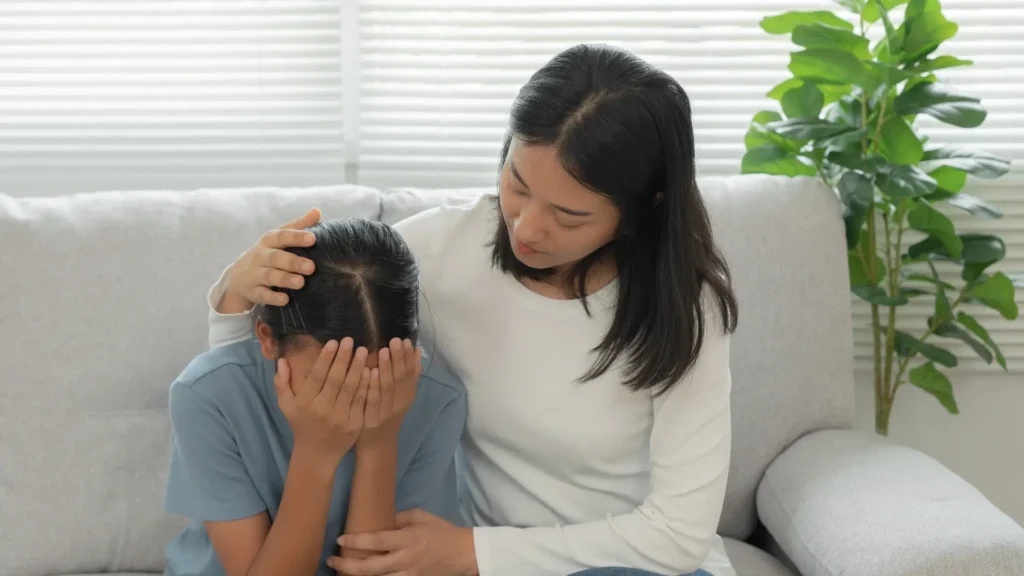When a child complains of abdominal pain, it can be a sign of various ailments, but when the pain is a symptom of appendicitis in children, it becomes a medical emergency that demands prompt attention. Appendicitis progresses quickly and can cause severe problems if not treated promptly. This article aims to guide parents on how to check for appendicitis in children at home.
As always, it is important to remember that these methods should not replace professional medical advice and diagnosis.
How Do I Know If My Child Has Appendicitis?
But first lets find out what Appendicitis is. Appendicitis is a critical medical condition where the appendix—a small, tube-shaped pouch attached to the large intestine—becomes inflamed and filled with pus. While it can occur at any age, certain factors increase the risk, such as a family history of the condition, certain infections, and gastrointestinal tract obstructions. Recognizing the early signs of appendicitis is pivotal for timely treatment.
Signs and Key Symptoms of Appendicitis in Children
The main symptom of appendicitis in children is abdominal pain that often starts near the belly button and then moves to the lower right side. This may be accompanied by:
- Nausea or vomiting
- A decrease in appetite
- Fever and general discomfort
- Potential swelling of the abdomen
Children might not always be able to explain their pain clearly. They may show their pain through changes in behavior such as increased irritability or tiredness. (Read more below)
Additionally, there are key symptoms to look out for:
- Sudden Abdominal Pain: Often starting around the navel and later moving to the right lower quadrant of the abdomen.
- Changes in Appetite: Your child may lose their appetite or refuse meals, which is uncommon for them.
- Gastrointestinal Symptoms: Nausea, vomiting, or both can occur and are signs that should raise concern, especially if paired with abdominal pain.
- Fever: A fever can indicate an infection or inflammation, such as appendicitis, especially when other symptoms are present.
- Uncharacteristic Behavior: If your child seems less active than usual or is reluctant to move due to discomfort, this could be a red flag.
Should these symptoms arise, gently press on the lower right side of your child’s abdomen. Watch for signs of pain when releasing pressure — a symptom known as rebound tenderness. Additionally, observe if your child experiences pain when coughing or walking; these can be indicative of appendicitis.
Take note that while parents can perform a preliminary check at home, only medical professionals can provide a definitive diagnosis. If your instincts suggest something isn’t right with your child’s health, trust them and contact a healthcare provider without delay. After recognizing these initial signs and symptoms at home, the next step involves understanding what limitations exist for home tests and when it’s time to seek professional medical care.
How to Check for Appendicitis in Children at Home: Assessing Pain in Children
Evaluating pain in children who may not communicate effectively can be difficult. The Pediatric Pain Face Scale and the Wong-Baker Faces Pain Rating Scale serve as valuable tools for measuring pain levels in young children, using a series of facial expressions to represent different levels of discomfort. By comparing a child’s expression to these scales, parents and healthcare providers can better understand how much pain they’re experiencing.

Both these visual aids feature faces ranging from a happy expression (no pain) to a crying face (severe pain).
Parents should remember that while these signs are helpful for an initial assessment at home, they cannot replace professional medical evaluation and diagnosis. If appendicitis is suspected, it’s crucial to seek medical attention promptly to prevent serious complications like a ruptured appendix.
Can Home Tests Help?
Parents might come across various home tests suggested to gauge the presence of appendicitis in children, such as discussed above. The reliability of home tests for appendicitis is, however, highly questionable. These methods are not definitive diagnostic tools and carry significant limitations:
- Accuracy: Home tests lack the precision that medical professionals achieve with their clinical assessments. For instance, the subtle differences in pain response or the presence of symptoms like Rovsing’s sign can be easily misinterpreted without proper medical training.
- Risk of Misdiagnosis: Incorrectly performing a test or misunderstanding the results could lead to a false sense of security or unnecessary panic. Considering appendicitis can rapidly progress to a life-threatening condition if not treated, relying on these informal assessments poses a substantial risk.
Medical practitioners use a combination of history-taking, physical examination, laboratory testing, and advanced imaging techniques to diagnose appendicitis accurately.
While parents’ observations at home are valuable, they should serve as prompts to seek professional medical evaluation rather than standalone diagnostic measures.
When to Seek Medical Care

Keeping an eye on your child’s health is no small task. It’s essential to be aware of potential appendicitis symptoms in your children. However, it’s important not to rely solely on your observations or at-home tests. You should always seek medical attention for a proper evaluation if you suspect appendicitis.
Healthcare professionals have the expertise and resources to determine whether your child’s discomfort is due to appendicitis or another condition. They can perform a physical examination, order lab tests, and use imaging techniques like CT scans, which are crucial for diagnosing appendicitis accurately.
The sooner you seek medical care, the better. Early diagnosis can help prevent complications like a ruptured appendix. If your child experiences severe abdominal pain or other worrisome symptoms, don’t wait—get immediate medical assistance.
How is Appendicitis in Kids Treated?
When a child is diagnosed with appendicitis, the primary treatment is almost always surgical removal of the appendix, known as an appendectomy. This procedure can be performed using two different methods:
- Laparoscopic Appendectomy: A minimally invasive surgery involving small incisions, a camera, and instruments to remove the appendix. This option usually leads to a quicker recovery and less pain post-operation.
- Open Appendectomy: In cases where the appendix has ruptured or the infection has spread, or if the surgeon needs a better view of the abdominal cavity, an open surgery might be necessary. This involves a larger incision in the lower right-hand side of the abdomen.
Post-surgery care is crucial for children to ensure a full recovery. Here are some typical steps followed:
- Pain Management: Children will receive pain medication to manage discomfort after surgery.
- Antibiotics: If the appendix ruptured or there was an infection, antibiotics would be prescribed to prevent or treat any ongoing infection.
- Fluids and Nutrition: Initially, fluids may be given intravenously (IV) until your child can take in liquids and food by mouth without complications.
- Rest and Gradual Activity: Rest is essential; however, healthcare providers will encourage light activity like walking to aid recovery and prevent complications.
In some instances where the appendicitis is not advanced and the inflammation is mild, antibiotics alone may be tried as initial treatment to settle the inflammation. But this approach is carefully selected for specific cases under close medical supervision.
Parents should understand that prompt treatment of appendicitis reduces the risk of complications such as rupture or infection spreading throughout the abdomen, known as peritonitis. Following a successful appendectomy, most children bounce back quickly with proper care and rest.
After discussing treatment options, it’s beneficial to consider other reasons your child might be experiencing abdominal pain that aren’t related to appendicitis.
Other Possible Causes of Abdominal Pain in Children
Abdominal pain in children triggers immediate concern, and rightly so. While appendicitis is a common cause, several other conditions can present with similar symptoms. Identifying the correct cause is essential for appropriate treatment.
Gastroenteritis
Gastroenteritis, often referred to as the stomach flu, is frequently mistaken for appendicitis. It’s characterized by:
- Stomach cramps
- Diarrhea
- Vomiting
- Fever in some cases
Unlike appendicitis, gastroenteritis is typically caused by a virus and tends to resolve on its own with rest, fluids, and supportive care.
Urinary Tract Infections (UTIs)
Urinary Tract Infections (UTIs) also mimic the presentation of appendicitis, especially in younger children who may not be able to articulate their symptoms clearly. UTIs may involve:
- Pain or burning during urination
- Frequent urge to urinate
- Lower abdominal pain
- Sometimes fever and back pain
If a child’s symptoms include changes in urination, a UTI might be the culprit. A simple urine test can confirm this diagnosis.
Other differential diagnoses for abdominal pain in children include but are not limited to conditions such as constipation, which can cause significant discomfort and is often overlooked, and intussusception, where part of the intestine slides into an adjacent part of the intestine, leading to severe, intermittent pain often accompanied by bloody stools.
Each of these conditions requires its unique approach to management. For example, while antibiotics would be used for treating UTIs, managing constipation often involves dietary changes and possibly laxatives. Recognizing these nuances helps tailor the right course of action for each child’s specific situation.
Helping Your Child Understand What’s Happening

When a child experiences symptoms that could be related to appendicitis, it’s essential to keep communication open and honest. Helping your child understand what’s happening in an age-appropriate way can alleviate some of their anxiety. Here are a few strategies:
- Use simple, reassuring language to explain the situation.
- Compare the appendix to something familiar, like a small pouch, and describe how sometimes it can get inflamed.
- Validate their feelings by acknowledging that it’s okay to feel scared or uncomfortable.
- Assure them that doctors are like detectives who can figure out what’s causing the pain.
- Emphasize that you’ll be there with them every step of the way.
Remember that helping children grasp medical issues in terms they can understand fosters trust and encourages them to communicate their feelings more openly.
Further Reading: How to Build Your Child’s Self Esteem During Puberty
Conclusion
Although parents are able to check for appendicitis in children at home, they cannot replace the thorough assessment and treatment options for appendicitis that healthcare experts can provide. The key to preventing serious problems and keeping your child healthy is early detection and immediate treatment.
Parents have a crucial role in protecting their children’s health. It is extremely important for parents to quickly identify symptoms that could be signs of appendicitis. Getting medical help right away is crucial, especially because delaying care can lead to serious complications like a ruptured appendix.


